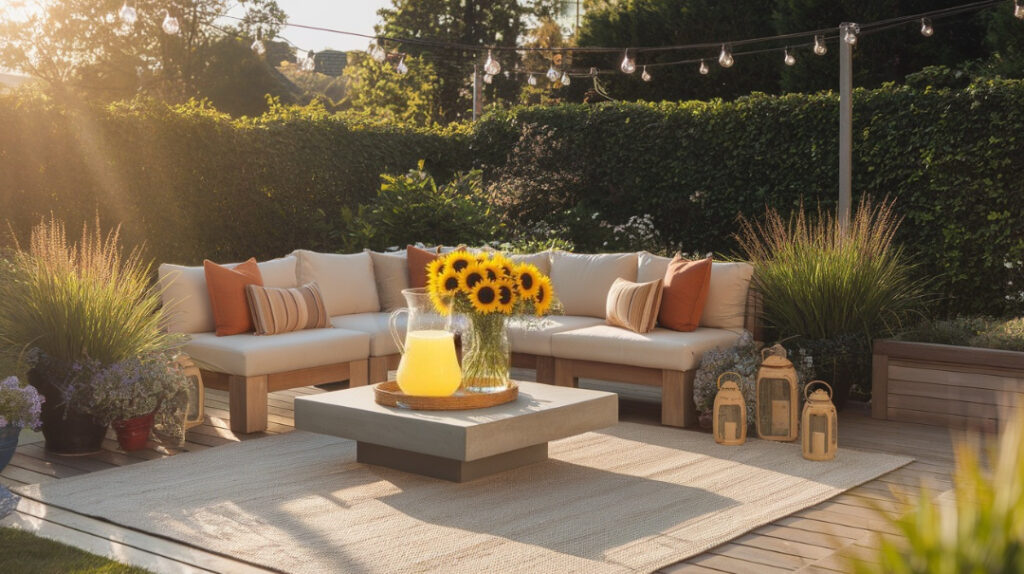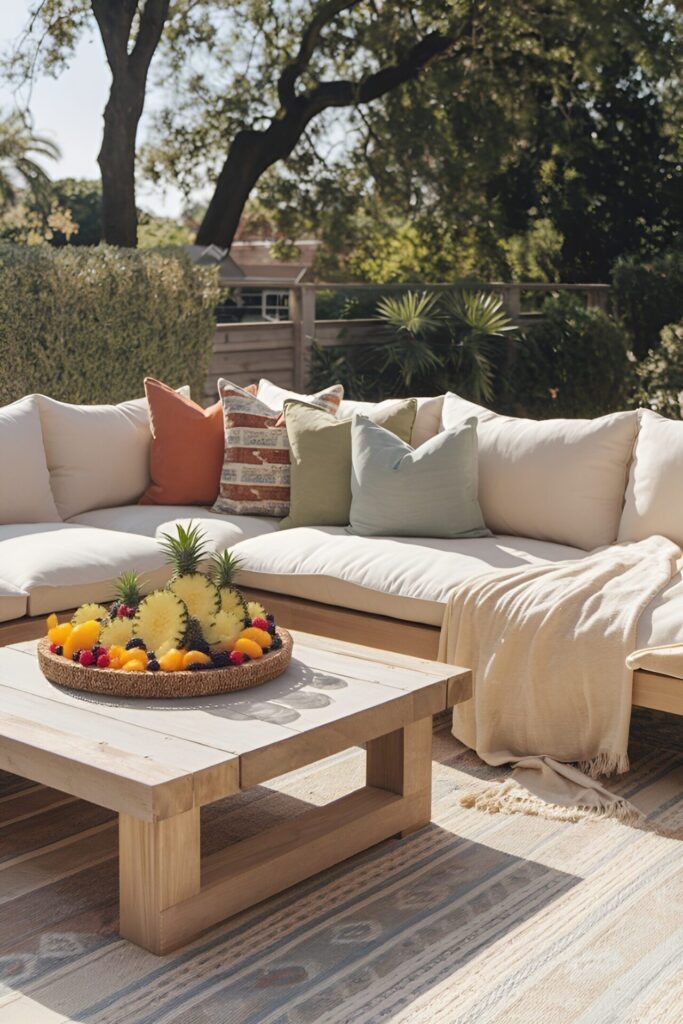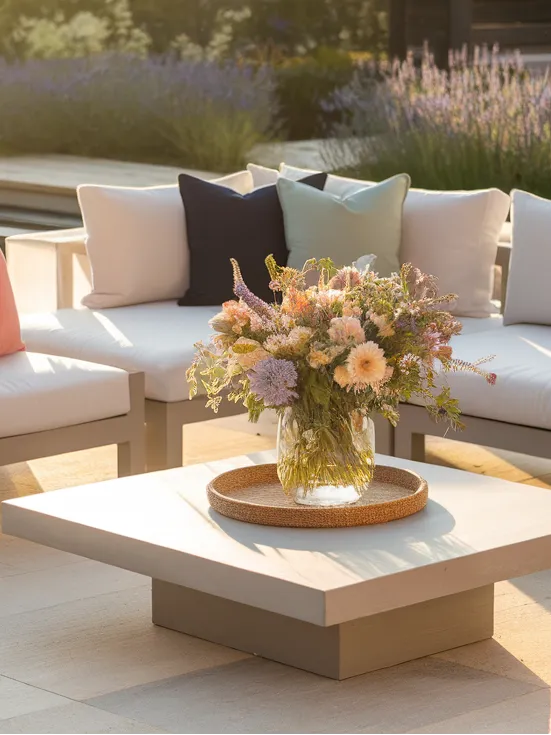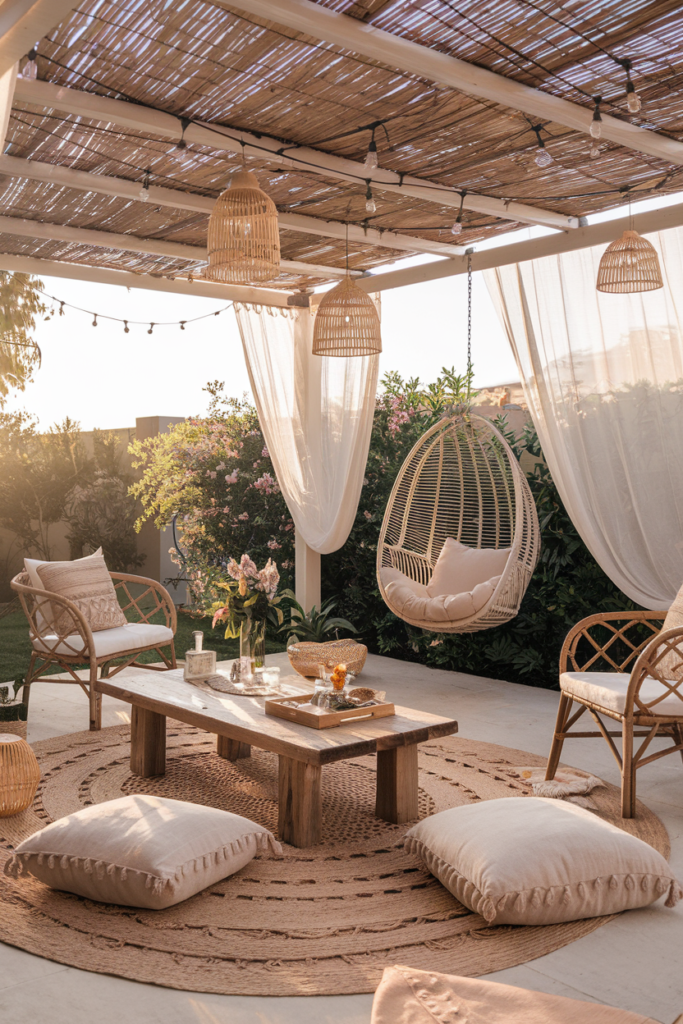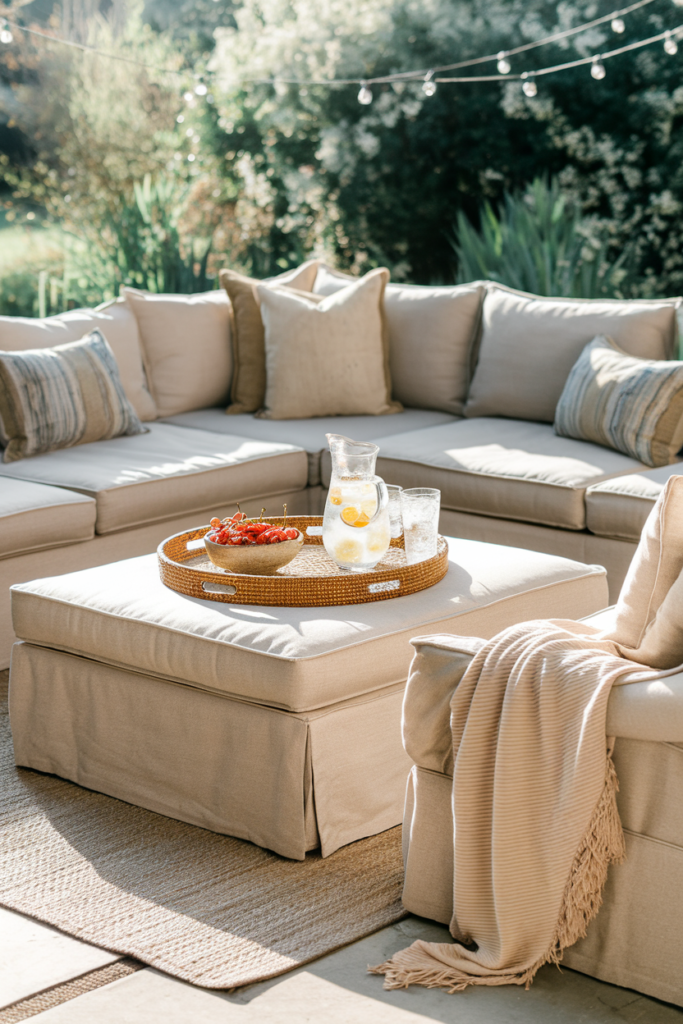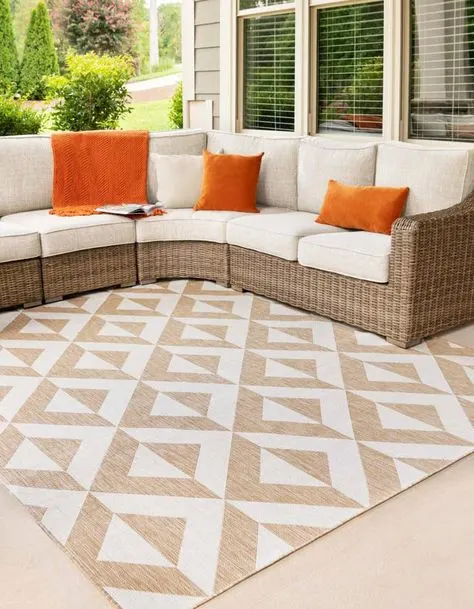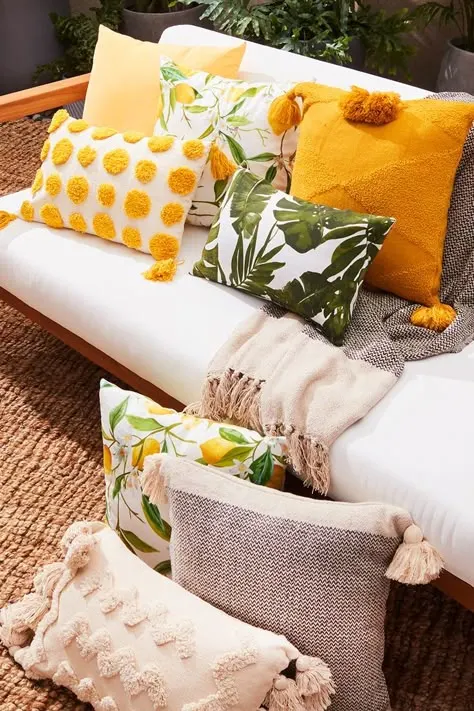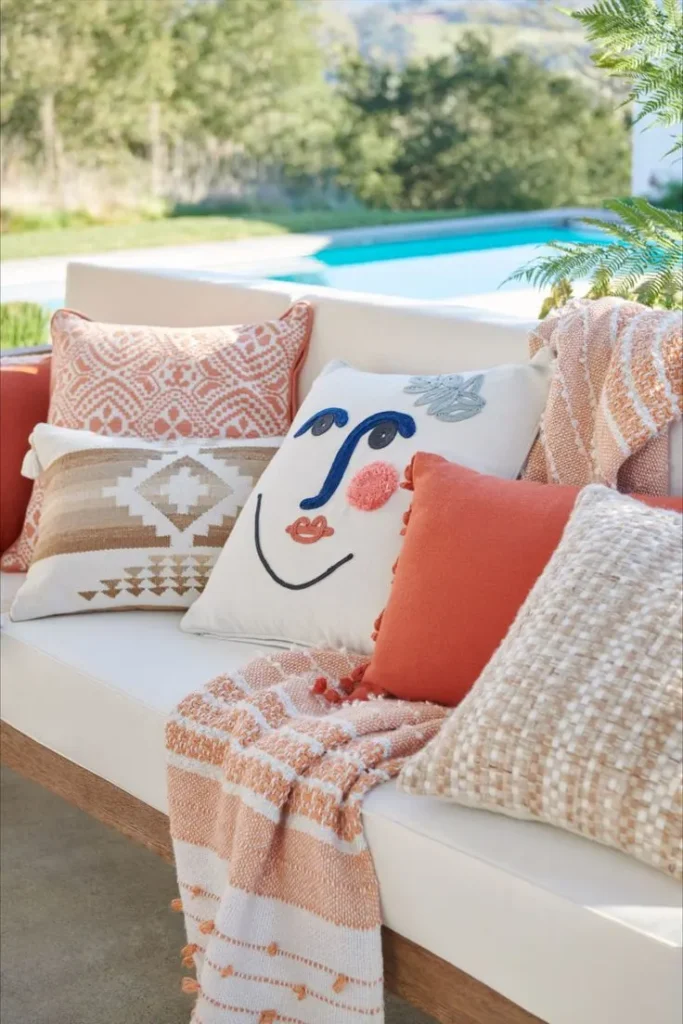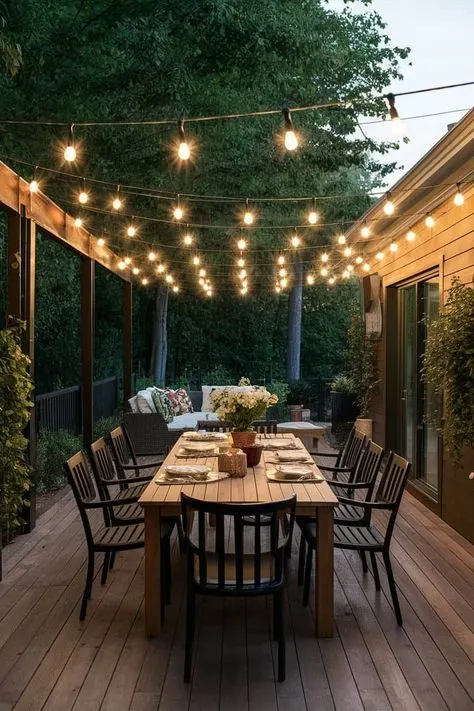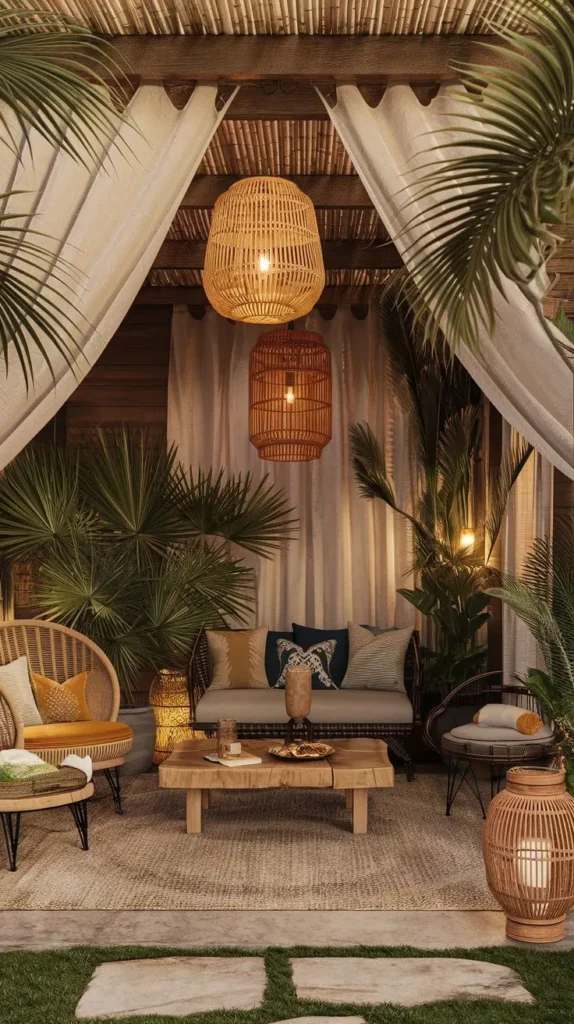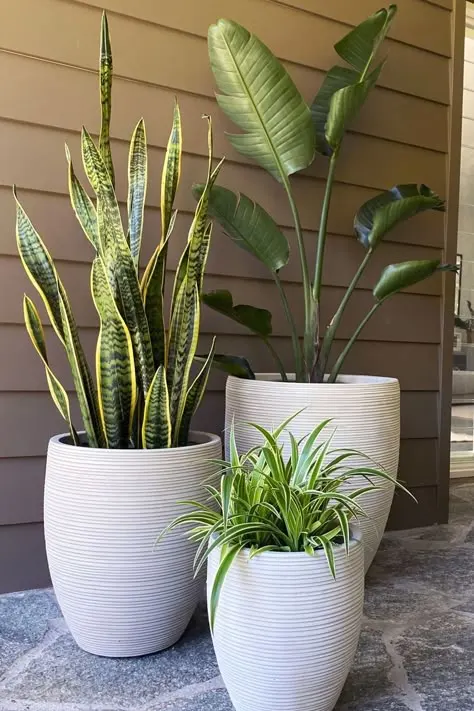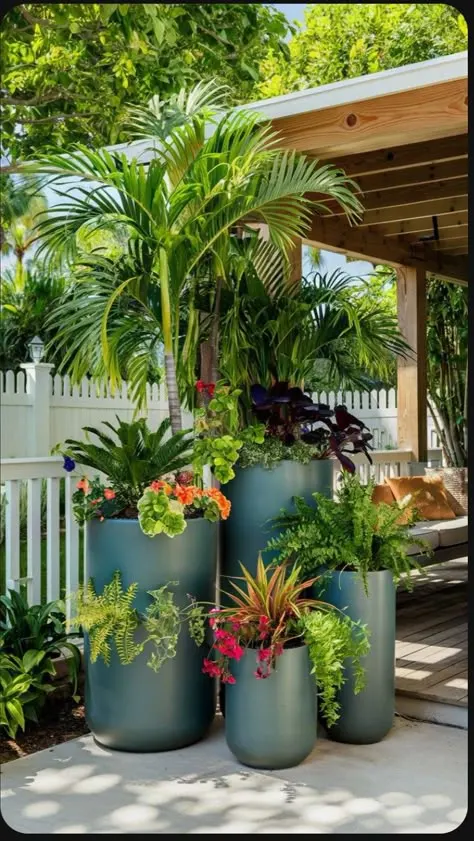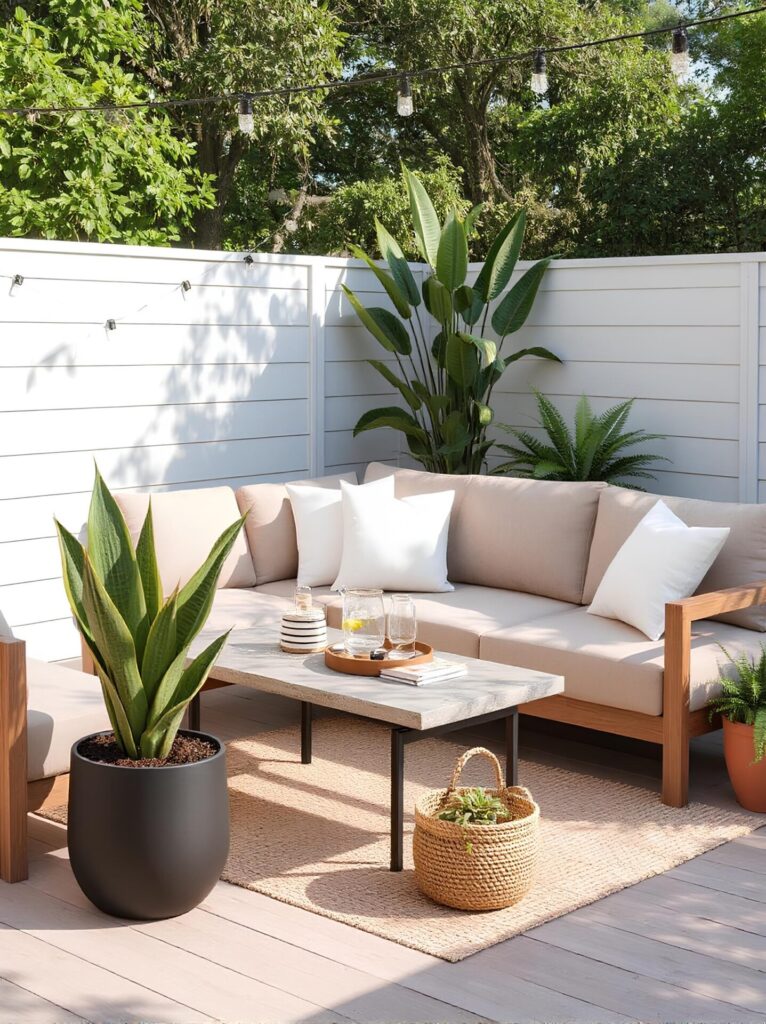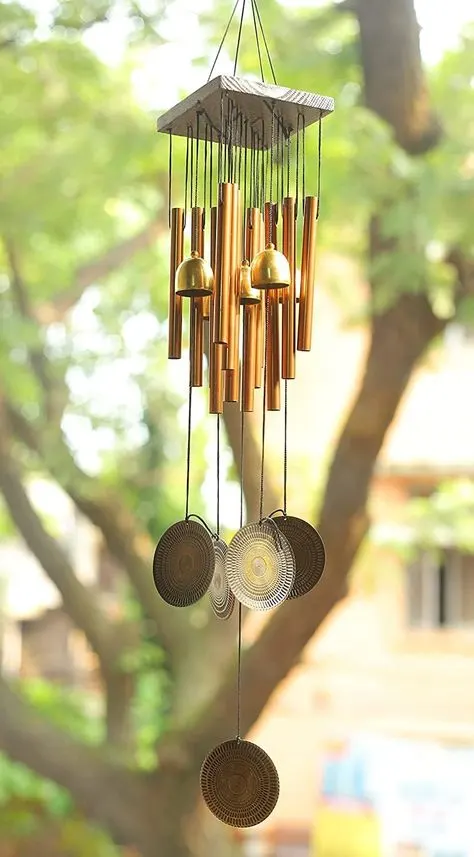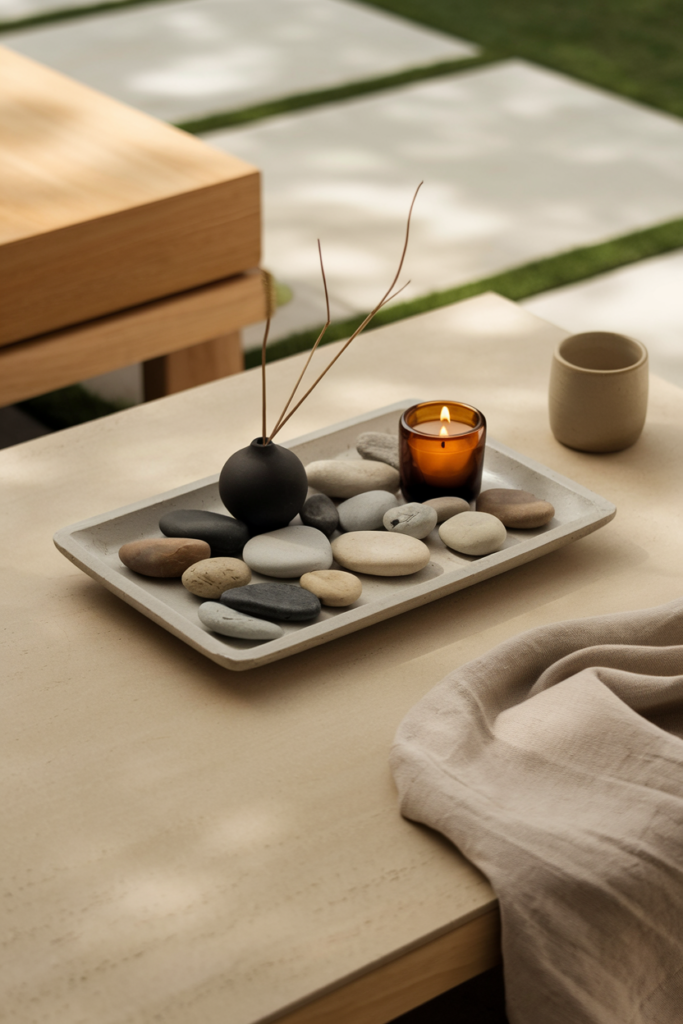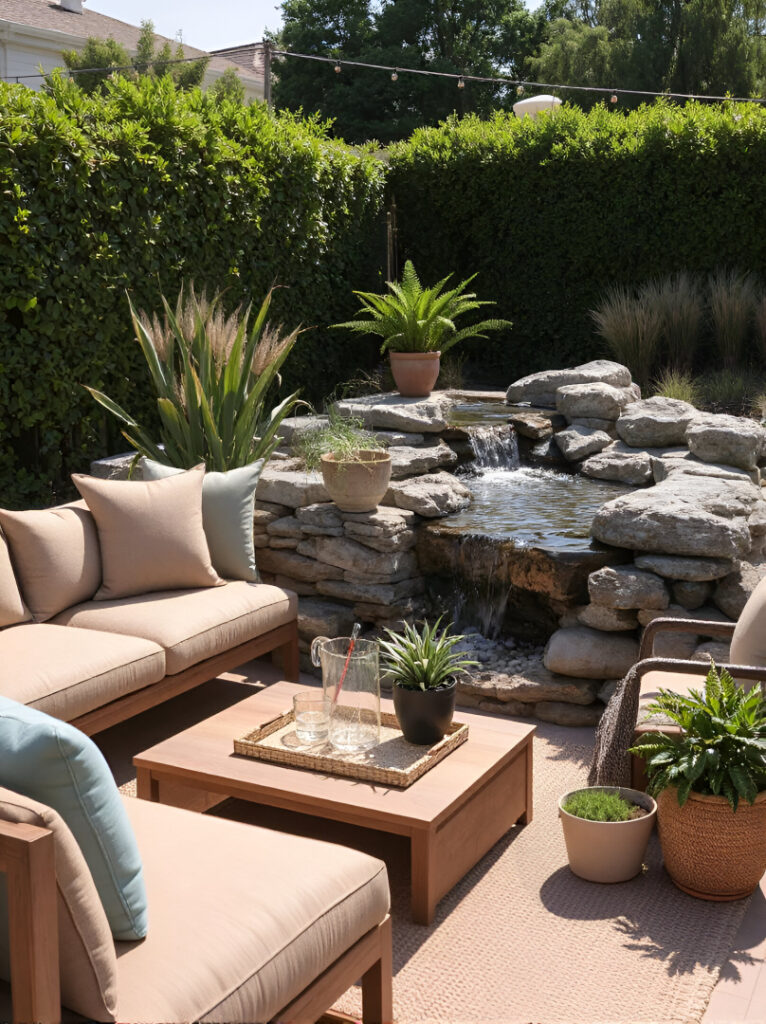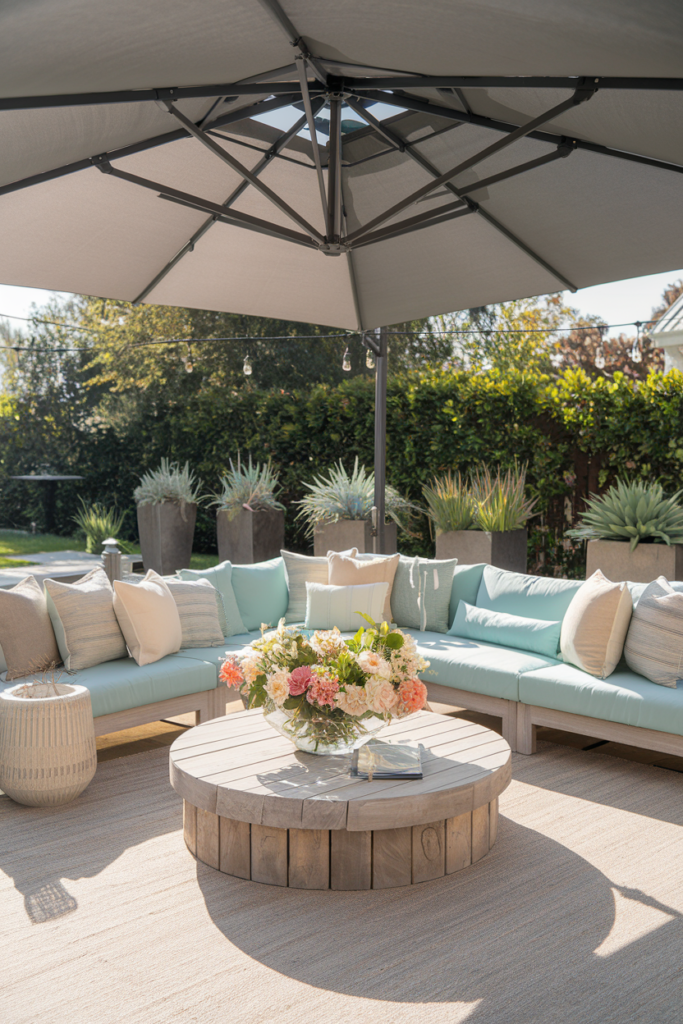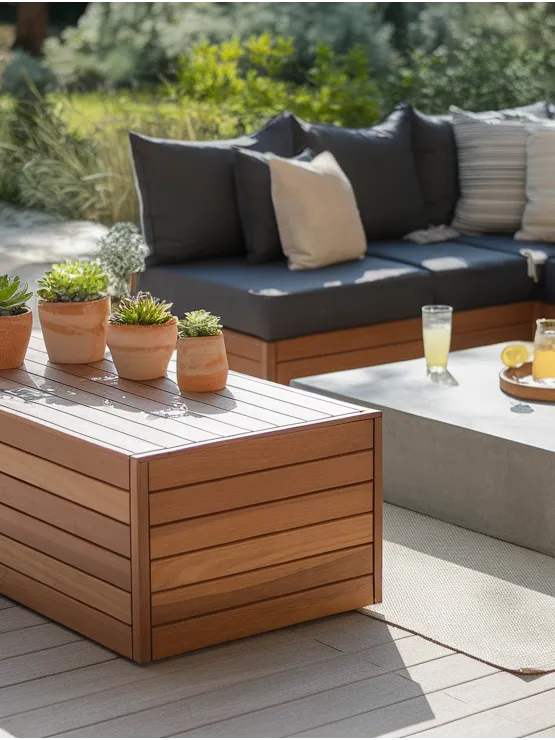There are affiliate links on this website. At no additional expense to you, I might receive a tiny commission.
This article shows How to Create a Cozy Backyard Oasis for Summer.
I used to think outdoor spaces were just places you passed through. You know—the patio where you occasionally grilled, the yard you mowed because the neighbors would judge if you didn’t. Functional, forgettable transitions between your actual living space and the rest of the world.
And then last summer happened. That weird, endless summer when my house felt simultaneously too small and too big. When I started eyeing that neglected corner of our backyard with something like desperation. If walls could close in, mine definitely were.
I remember dragging an old armchair outside one evening—just to breathe different air—and something clicked. The way the evening light filtered through our scraggly maple tree transformed even that sad, patchy grass into something almost magical. I sat there until mosquitoes drove me inside, thinking: why haven’t I been living out here all along?
That’s the thing about outdoor spaces—they’re not just bonus square footage. They’re sanctuaries waiting to happen. Extensions of ourselves that somehow feel more honest than perfectly styled living rooms.
Defining Your Space: Considering Your Backyard’s Potential
Everyone talks about “assessing your space” like it’s some clinical exercise. Measure, calculate, evaluate. But honestly? The best way to understand your outdoor space is to just… exist in it. I spent a week wandering out at random hours with my coffee, sitting in different spots.
That corner by the fence? Morning sanctuary, afternoon inferno. The area under the old oak? Perpetually damp but perfectly cool on the hottest days. The middle section? Exposed in a way that made me feel like I was on display for the entire neighborhood.
Your yard has personality. Moods that shift with the sun and seasons. Working with these natural tendencies instead of fighting them makes everything easier. Trust me—I learned this after trying to grow sun-loving plants in our shadiest corner for three consecutive summers.
I’m not saying you need a formal yard analysis, but just spend time there. Notice where you naturally want to linger. Where you instinctively avoid. The paths your feet take without thinking. Your body knows where it wants to be comfortable before your brain catches up.
For us, it became obvious our yard wanted to be divided. The sunny spot near the house became our dining area. The shaded corner under the maple transformed into our lounging zone. And that awkward transition space? Perfect for container gardens that created natural flow between the two.
The Essential Elements of Cozy Comfort
Seating that Invites Relaxation
I have a theory about outdoor furniture: we’ve collectively agreed to tolerate discomfort outside in ways we never would inside. Those spindly metal chairs that leave grid patterns on your thighs. Rock-hard benches. Loungers that somehow make your back hurt worse than standing.
Why? Probably because outdoor furniture used to be purely functional—something weatherproof to occasionally sit on while you watched kids play or flipped burgers.
But if you’re creating a true outdoor living space? Comfort isn’t optional. It’s non-negotiable.
After sitting on what felt like every outdoor sofa in three counties (much to my husband’s mounting impatience), I realized something: there’s outdoor furniture, and then there’s outdoor living furniture. The difference is whether you can actually imagine spending hours there.
We ended up with a deep-seated sectional with Sunbrella fabric cushions that feels like an actual couch, not a compromise. Yes, it was more expensive than I planned. No, I don’t regret it for a second. Because now we actually use our outdoor space instead of just looking at it through the window.
If you’re working with a smaller budget or space, don’t worry. My friend Mia created the coziest balcony setup with oversized floor cushions, a vintage rattan peacock chair, and a hammock swing. The key is variety—different heights, different postures, different ways to get comfortable depending on your mood.
The non-negotiable? At least one spot where you can fully recline. Trust me on this. Whether it’s a daybed, a chaise lounge, or even a collection of massive pillows on an outdoor rug—having a place where you can stretch out changes everything. It transforms “sitting outside” into “living outside.”
Anchoring with an Outdoor Rug
I never quite understood outdoor rugs until I had one. They seemed like unnecessary decoration—something that would get dirty immediately and be a pain to clean. I was wrong. So, so wrong.
An outdoor rug doesn’t just look good—it fundamentally changes how a space feels. It’s the difference between “some furniture on grass” and “an outdoor room.” That simple rectangle of texture anchors everything, creating invisible walls where none exist.
We found a geometric-patterned polypropylene rug that’s survived two years of rainstorms, fallen leaves, and one memorably disastrous red wine incident. It dries quickly, cleans easily with a hose, and somehow still looks good.
What I love most is the feeling of bare feet on something other than grass or concrete. That simple tactile pleasure makes the space feel intentional—like someone thought about the experience, not just the appearance.
The right outdoor rug doesn’t need to be expensive, but it does need to be weather-resistant. Natural fibers like jute look amazing but can mildew and fall apart after a season of rain. Synthetic materials like polypropylene or recycled plastic might not sound glamorous, but they’ll survive whatever your climate throws at them.
The Magic of Soft Furnishings
If there’s one place people undercommit in outdoor spaces, it’s pillows and throws. We go all-in on furniture, maybe add plants, and then stop—as if comfort ends at having somewhere to sit. But it’s the textiles that transform good enough into genuinely cozy.
My outdoor pillow collection started small—two blue cushions that came with the sofa. Now? It’s possibly out of control. Striped pillows, block-printed pillows, a ridiculously large floor cushion my husband threatens to “accidentally” leave out in the rain. Each one adds a layer of comfort and personality.
The key is weather-resistant fabrics. Regular indoor pillows will grow mildew, fade dramatically, or simply disintegrate after a season outdoors. Look for solution-dyed acrylic fabrics or polyester blends specifically made for outdoors. They’ll cost more upfront but save you from replacing everything annually.
And throws? Absolute game-changers for extending your outdoor season. Those first crisp evenings when summer starts yielding to fall? A basket of blankets by the sofa means you can still linger outside. We found lightweight cotton throws for summer evenings and heavier indoor/outdoor blankets for genuine chills.
The colors and patterns you choose set the mood. Want calm and serene? Stick with neutrals and natural textures. Craving something energizing? Mix bold patterns and complementary colors. There’s no wrong answer—just what makes you feel good when you see it.
Setting the Mood: Ambiance and Atmosphere
Lighting for Enchanting Evenings
I used to think outdoor lighting meant that one harsh spotlight over the back door that attracted every moth within a five-mile radius. Functional? Sure. Magical? Not exactly.
The revelation came after string lights went up over our dining area. Suddenly, we were lingering outside long after sunset. Food tasted better. Conversations got deeper. The simplest weeknight dinner felt like we’d been transported to some little European courtyard.
That’s the thing about good lighting—it transforms time as much as space.
For our lounge area, we layered different light sources. String lights overhead create that starry ceiling effect. Solar pathway lights offer subtle guidance without harsh brightness. Battery-operated candles (because I will absolutely forget to blow out real ones) add flickering warmth to the coffee table.
The best outdoor lighting creates pools of brightness with gentle transitions between them—not uniform illumination. Think about where you need functional light (steps, cooking areas) versus where you want atmospheric glow (seating areas, around plants).
Solar options have improved dramatically in recent years. Our pathway lights charge during the day and automatically illuminate at dusk, which means one less thing to remember. For areas where we needed more reliable brightness, we installed low-voltage landscape lighting—not complicated if you’re moderately handy (or have a partner who is).
Embracing Greenery
I kill plants. This is not a self-deprecating exaggeration—it’s a well-documented fact that has become something of a family joke. I’ve killed succulents, which everyone swears are impossible to kill. I’ve killed plants specifically marketed as “unkillable.”
And yet. My outdoor lounge is surrounded by thriving greenery that makes the space feel alive and breathing.
The secret? I finally accepted my limitations and chose plants accordingly. No more delicate flowers requiring deadheading or precise watering schedules. No more tropical varieties needing winter protection. Instead, native perennials that actually want to live in our climate, sturdy grasses that add movement and texture, and large-leaved tropicals that can live indoors during winter.
Plants soften hard edges, create privacy, filter light, attract birds and butterflies, and make a space feel established rather than freshly assembled from a catalog. They’re worth the effort—even for the horticulturally challenged among us.
If you share my black thumb tendencies, start with forgiving varieties like hostas, ornamental grasses, pothos, or snake plants. Group them in clusters rather than spreading them out—they’ll create more visual impact and often do better with shared humidity.
And containers? They’re outdoor decorating magic. You can move them around as needed, bring sensitive plants in during weather extremes, and experiment without committing to permanent garden beds. We started with three large planters creating a natural screen between our lounge area and the neighbor’s view. Now we have…more than three. Definitely more than I initially planned. But each one adds color, texture, and life.
Adding Personal Touches
This might be where I diverge from typical outdoor design advice. Most guides suggest “weatherproof art” or “outdoor accessories” that are practically indistinguishable from every outdoor furniture display.
But the best outdoor spaces have personality—something that tells you whose space you’re in.
For us, it’s the ridiculous wind chimes my husband brought home from a road trip—metal tubes that create surprisingly beautiful, almost otherworldly tones when breeze catches them. It’s the collection of smooth river stones our daughter arranges and rearranges on the coffee table. It’s the outdoor-safe speaker disguised as a rock (yes, really) that my tech-enthusiast brother gave us.
None of these things would appear in a design magazine spread. But they’re the elements that make our outdoor lounge distinctly ours.
Your personal touches might be different—outdoor art you love, a small waterfall that masks traffic noise, lanterns collected on travels, or strings of prayer flags bringing color and movement. The only requirement is that they mean something to you.
Practical Considerations for Long-Term Enjoyment
The dream of outdoor living can quickly become a maintenance nightmare without some practical planning. Trust me—I learned this the hard way.
Shade is non-negotiable. Even if you love sunbathing, you need options. Our west-facing lounge area becomes unbearably hot around 3 PM in summer without intervention. After one memorable gathering where guests kept subtly migrating indoors, we invested in a large cantilever umbrella that can be positioned exactly where needed as the sun moves.
If your space allows, permanent shade structures like pergolas or shade sails offer more substantial relief. We have friends who installed a simple wooden pergola and grew grape vines across the top—creating dappled, living shade that changes with the seasons.
Weather protection is the other big consideration. Our first outdoor rug was beautiful—for about three months. Then autumn leaves fell, decomposed onto it during winter rains, and by spring, it was a moldy disaster. Now everything either comes inside during off-seasons or has dedicated protection.
Furniture covers aren’t exciting purchases, but they dramatically extend the life of your investment. Same for proper winter storage of cushions and textiles. We converted a rarely-used garden shed into seasonal storage, but weather-resistant deck boxes work just as well for smaller spaces.
Final Thoughts: Your Summer Sanctuary Awaits
Creating our outdoor lounge took time—and a few mistakes. Our first string lights were too dim, the side table too small, and the furniture arrangement felt off. But that’s how real spaces come together: by living in them, adjusting, and noticing what makes them better.
Your outdoor space doesn’t need to be magazine-perfect. It just needs to draw you outside, to feel like a natural extension of your life. As I write this from our lounge—cold coffee beside me, wind chimes in the background, weeds and all—I’m reminded that it’s the imperfections that make it ours.
Your backyard oasis doesn’t have to wait. Start simple: pull up a chair, sit outside, and let your space tell you what it wants to become.
Loved these cozy backyard ideas? Leave a comment, save this post for later, and share it with a friend who’s dreaming of their own outdoor oasis!
